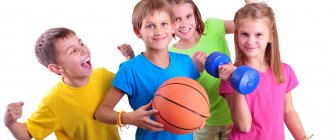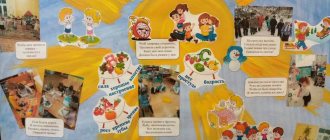Program to form the foundations of a healthy lifestyle for preschool children
4) Personal and professional growth, self-realization, moral satisfaction.
For children:
1) Developed healthy lifestyle skills. 2) Proper physical development of the child’s body, increasing its resistance to infections.
3) Improving somatic health indicators and physical fitness indicators.
4) The formation of a hygienic culture, the presence of a need for a healthy lifestyle and the possibilities of providing it.
For parents:
1) Formed active parental position. 2) Increasing the competence of parents in matters of physical development and health.
3) Active participation of parents in the life of the preschool educational institution.
Technologies for creating a healthy lifestyle
The classification of health-saving technologies in preschool education is determined by the dominance of goals and tasks to be solved, as well as the leading means of health-saving and health-enrichment of the pedagogical process in kindergarten.
In this regard, the following types of health-saving technologies can be distinguished:
Medical and preventive technologies
— technologies that ensure the preservation and enhancement of children’s health under the guidance of preschool medical personnel in accordance with medical requirements and standards, using medical supplies.
These include the following technologies:
organizing monitoring of the health of preschool children and developing recommendations for optimizing children's health;
organization and control of nutrition for children of early and preschool age, physical development of preschool children, hardening;
organization of preventive measures in kindergarten;
organization of control and assistance in meeting SanPiN requirements;
organization of a health-preserving environment in preschool educational institutions.
Physical education and health technologies
– technologies aimed at the physical development and strengthening of the child’s health: the development of physical qualities, motor activity and the formation of physical culture of preschool children, hardening, breathing exercises, massage and self-massage, prevention of flat feet and the formation of correct posture, health procedures in the aquatic environment, nurturing habits for everyday life physical activity and health care, etc. the implementation of these technologies is carried out by physical education specialists and preschool teachers in the conditions of specially organized forms of health-improving work.
Health-saving educational technologies in kindergarten
are,
first of all, technologies for educating a valeological culture or a culture of health in preschoolers. The purpose of these technologies is to develop a child’s conscious attitude towards health and human life, accumulate knowledge about health and develop the ability to protect, support and preserve it, acquire valeological competence, allowing a preschooler to independently and effectively solve the problems of a healthy lifestyle and safe behavior, tasks associated with provision of basic medical and psychological self-help and assistance.
MAGAZINE Preschooler.RF
Work experience “Introducing preschool children to a healthy lifestyle”Lebedeva Tatyana Vladimirovna, Teacher of the highest qualification category, MDOU "Kindergarten "Romashka" , Nizhny Novgorod region, Kovernino village
“I am not afraid to say again and again that taking care of health is the most important job of a teacher. Their spiritual life, worldview, and mental development depend on the cheerfulness and vigor of children.” V.A. Sukhomlinsky
Being healthy is the natural desire of every person. The foundations of physical and mental health are laid in childhood, and therefore it is very important to form the habit of a healthy lifestyle in a person from childhood. We need to teach a child to love himself, people, and life. Only a person living in harmony with himself and with the world will be truly healthy.
A person’s health depends entirely on his lifestyle and behavior. That is why it is so important to teach a child from childhood to take care of himself, to preserve, develop, and increase what is given by nature itself. It is important to teach your child to understand how valuable health is for a person and how important it is to strive for a healthy lifestyle.
Preschool age is decisive in forming the foundation for the physical and psychological health of children. It is during this period that there is intensive development of organs and the formation of functional systems of the body, the basic personality traits are laid, character, attitude towards oneself and towards others are formed. During this period, the child develops basic skills for developing a healthy lifestyle culture; this is the most favorable time for developing the right habits, which, in combination with teaching preschoolers how to improve and maintain health, will lead to positive results. Therefore, in my work I pay great attention to introducing children to a healthy lifestyle.
In preschool age, during the period of intensive growth and development of children, it is especially important to ensure an optimal mode of physical activity that promotes the timely development of motor skills and the correct formation of the most important organs and systems.
Movement is a vital necessity and human need. A small child is a doer! And his activity is expressed, first of all, in movements.
When organizing physical activity, I use the following forms: physical education classes, morning exercises, outdoor games, recreational gymnastics, physical education leisure activities: “Fun Starts” , “We are strong friends with sports . When spending leisure time, children are involved in direct participation in various competitions and competitions, and enthusiastically complete the proposed tasks. This promotes the development of thinking, imagination, determination, as well as the formation of a sense of responsibility, teaches them to restrain their desires and show determination.
Physical education activities are of great importance for strengthening the child’s body. When organizing physical education classes, I adhere to the following principles: individual approach, gradualism, systematicity, taking into account the emotional state of the child. I conduct classes in a playful way, based on the plot of fairy tales familiar to children. To maintain children's interest in physical activity, I use nursery rhymes and dynamic pauses. Emotionally colored, they make movements desirable and achievable for children.
Throughout the day, I take a moment to please the children by doing the following exercises: stretch like a cat, roll like a tumbler, crawl like a snake without using your hands. This is very important for the development and strengthening of the child’s musculoskeletal system.
Outdoor games occupy a significant place in the physical education system. It is known that play is the leading activity of preschool children. Games are an integral part of raising children of different ages. Some of them develop dexterity, accuracy, speed and strength in children, others teach the wisdom of life, goodness and justice, honor and decency, love and duty.
The purpose of the games is to strengthen children’s health, strengthen and improve their motor skills. During outdoor games, children learn to win among equals in strength and dexterity, and to show attention to younger ones. Therefore, it is so important to use interesting, varied game situations that strengthen friendly relationships and mutual understanding. I try to select outdoor games with different themes, that is, games with a specific plot, games with motor tasks, games with competitive moments.
During the game, I try to highlight the successes of diligent participants, stimulate the less active ones, and give new children the opportunity to take a closer look at the fun gaming atmosphere.
Health promotion is one of the leading activities of a kindergarten teacher. The main requirement is to prevent a decrease in the existing level of children’s health, to help improve it through a clearly thought-out system of work, including physical education and recreational activities. Therefore, I developed algorithms for health-improving activities carried out with children in the morning and after naps. I use various forms of health-improving work: morning exercises, if possible, in the fresh air, which allows you to get a boost of energy, articulation and breathing exercises, music therapy, recreational and outdoor games, finger exercises, dynamic pauses, walking on exercise machines, various types of massage ( "Hedgehogs" " , "Crackers" ), walking barefoot, rinsing your mouth after every meal.
I use finger games every day in my work. Systematic finger exercises are a powerful means of increasing brain performance.
Our group has a card index of finger games, accompanying exercises, manuals for the development of fine motor skills, various objects for performing exercises (corks, counting sticks, buttons, hedgehog balls, etc.)
Music therapy is one of the methods that improves the health of children and gives children pleasure. Music promotes the development of creativity, imagination, and strengthens their moral health. The melody is especially effective on hyperactive children, increases interest in the world around them, and contributes to the development of the child’s culture. I use music when organizing both organized children's activities and joint activities during routine moments: before naps and during sleep, when conducting recreational gymnastics, etc. The classical music of Mozart, Vivaldi, Tchaikovsky, and Grieg especially helps me carry out educational and educational tasks.
It is impossible to develop a child without creating appropriate conditions for this. Therefore, one of the important stages in instilling the basics of a healthy lifestyle in children is the creation of a spatial subject-development environment in the group.
A properly organized motor subject-development environment provides wide scope for the manifestation of individual motor capabilities, allows children to fully develop their abilities and demonstrate independence.
The group has created a physical education corner “Healthy” , which houses various sports equipment and teaching aids. All this increases children’s interest in physical education, increases the effectiveness of classes, and allows children to practice all types of basic movements indoors. The physical education corner serves to satisfy the preschooler’s need for movement and introduce him to a healthy lifestyle.
It is equally important in preschool age to develop children’s knowledge about health and a healthy lifestyle. After all, their future lives will largely depend on this. It is very important to “grow up correctly” : not to acquire bad habits, and most importantly, to learn how to control the body in order to maintain and improve health.
In order to manage the body, you need, first of all, to know how it is structured, how it works, what and why is useful for it and what is harmful. In preschool, it is important to help children “look” inside their own bodies and think about whether you are taking good care of your health. Therefore, in my work I pay great attention to the valeological education of children.
I carry out valueological education of preschoolers, adhering to the following principles:
- Systematic approach, i.e. education is not carried out in isolation, but in connection with the moral, aesthetic, psychophysical formation of the child’s level of development. It is impossible to keep the body healthy if you do not improve the emotional-volitional sphere, if you do not work with the soul and morality. Successful solution of the problems of valeology education is possible only by combining the efforts of the kindergarten and parents.
- Activity approach. Valueological culture is mastered by children in the process of joint activities with adults.
- “Do no harm” principle provides for the use of only safe healing techniques in work.
- The principle of humanism. In valeological education, the intrinsic value of the child’s personality is recognized. The moral guidelines of education are universal human values.
- The principle of altruism. Provides for the need to share the mastered values of valeological culture: “If you learn it yourself, teach it to a friend.”
- The principle of measure. Anything in moderation is good for health.
In the course of my work, I conduct various conversations on the topics: “The human body” , “Our helpers” , during which I introduce children to the parts of the body and sense organs, form an idea of their significance for human life and health (hands do many useful things, legs help move, etc.), about ways to care for your body, expand your understanding of the role of hygiene and daily routine for health, and about the place of man in nature.
I formulate in children the need for a healthy lifestyle, instilling an interest in physical education and sports. At them, children acquire valuable information about their body, its needs, ways to prevent injuries, and types of hardening. I introduce children to sports by organizing a thematic exhibition “Sports near us” . I teach the children poems and proverbs about health. I also design exhibitions of children’s drawings on the themes: “We love sports” , “Vitamins in the garden” , etc.
I give children the necessary information about hygiene culture and rules of behavior. I constantly train children in hygiene and self-care skills: putting on, buttoning, tying, untying, taking off, carefully putting or hanging clothes, etc. For children, this is simply a necessary and exciting activity, as a result of which my pupils begin to understand: why they need to wash themselves, wash their hands, why they need sleep and exercise, ventilation of the room, walks, why they need to stand and sit straight, eat carefully, use a napkin, rinse your mouth. I gradually instill cultural and hygienic skills in children in everyday life in the process of various activities and recreation, i.e. in each mode component.
The appearance of others is of great importance. I always remember that children are very observant and prone to imitation, so I try to be a worthy example for them.
So, step by step, my students accumulate experience in preserving and maintaining health, and acquire the appropriate competence.
One of the areas of my work in introducing children to a healthy lifestyle is working to ensure the emotional well-being of children. The emotional well-being of a child largely depends on the emotional microclimate of the group. A sensitive and attentive attitude towards children gives them the opportunity to feel comfortable and cozy, provides a good mood, a feeling of security, and therefore good contact with adults and peers, a calm response to requests and comments. This helps me instill in children respect for each other, develop the ability to listen patiently and respond adequately to the situation, and also develop a willingness to communicate.
The search for effective ways to preserve and strengthen the health of preschool children involves increasing the role of parents in matters of children's health, introducing them to a healthy lifestyle, and creating family traditions of physical education. An important way to implement cooperation between teachers and parents is to organize joint activities in which parents are not passive observers of the pedagogical process, but its active participants. Only subject to the implementation of continuity of physical education and health work in a preschool institution and the family, and the targeted activities of parents and teachers, can positive dynamics of indicators characterizing the health of children be ensured. Therefore, I pay great attention to interaction with my family.
In my work I use such forms as parent meetings, consultations “Health is the head of everything” , “The role of the family in the physical education of a child” , “Games that can be played at home” , discussions; individual conversations “Hygiene of our children” , “Clothing and health of children” , exhibitions of children's works, visits to families at home.
At the parent meeting “Children’s health is our common task,” I drew the attention of parents to the fact that knowledge about a person, movement patterns, hardening, personal hygiene, and daily routine will help them raise their child active and healthy.
The conducted seminars and workshops “Children’s health is in our hands” , “Outdoor games as a means of strengthening children’s health” helped parents learn the technologies of massages, breathing exercises and engage in the improvement of children’s health not only in kindergarten, but also at home.
When communicating with parents, I always recommend that they use the most effective forms of family work, such as:
- morning exercises
- hardening procedures
- physical exercise and outdoor games
- walks in the open air
“Healthy Guy” stand , the purpose of which is to support parents’ interest in preserving the health of their children and answer questions of interest. The information in the parents' corner allowed me not only to attract the attention of parents to the problem of children's health, but also to encourage them to communicate.
With great pleasure, parents take part in family competitions “Sports Family” , “Fun Starts” , “Dad, Mom, Me - a Sports Family” , where families show their physical skills in various sports competitions, and most importantly receive a charge of cheerfulness and good moods.
Thus, the use of variable forms of work with parents allowed me to establish communicative connections with the families of pupils and interest them in the results of health-improving work. Parents take an active part in activities aimed at maintaining health.
An analysis of my work proves that as a result of the activities carried out with children and their parents to raise a healthy child, I was able to form in children a conscious attitude towards their health. Children mastered the simplest self-healing skills. All this allowed me to achieve a significant reduction in the incidence of children.
The incidence of illness has decreased, which means that the direction of my work with children and the developed system of working with parents justifies its purpose, allowing my students to be physically, mentally and socially more prosperous.
| Next > |
Work plan on healthy lifestyle in the senior group
Evgeniya
Work plan on healthy lifestyle in the senior group
Work plan on health conservation with children of senior preschool age.
for the 2019-2020 academic year. G.
The health of children is the health of the nation!” This slogan is reflected in many educational documents, including the Federal State Educational Standards for Preschool Education. According to the Federal State Educational Standard, one of the priority areas of the kindergarten’s activities is carrying out physical education and health activities , including through the use of health-saving technologies in preschool educational institutions.
Goal: to provide the preschooler with the opportunity to maintain health, to develop in him the necessary knowledge, skills and abilities for a healthy lifestyle, and to teach him to use the acquired knowledge in everyday life.
Tasks:
— To form ideas about health, its value, healthy habits that improve health, about preventive and health measures;
-Promote the development of children’s independence in performing cultural and hygienic skills and vital habits;
— Develop the ability to avoid situations hazardous to health, seek the help of an adult if they arise;
-Develop the ability to simply describe one’s well-being, the ability to attract the attention of an adult in case of poor health or malaise;
-Ensure the preservation and strengthening of the physical and mental health of children.
September
To form in children the idea of the need to take care of their own health
1. Conversation “Take care of your health from a young age”
.
2. Lesson “Help Dunno preserve his health”
.
3. Reading K. Chukovsky “Doctor Aibolit”
.
4. Analysis and memorization of proverbs about a healthy lifestyle.
5. Role-playing games “Polyclinic”
,
"Hospital"
,
"Veterinary hospital"
.
6. Design of the mobile folder “Child Health Improvement System”
"Personal hygiene"
7. Consultation “Organization of family outings”
October:
To develop in children an understanding of the importance and necessity of hygiene procedures.
1. Conversation “Good and bad habits”
2. Lesson “To be healthy”
.
3. Reading: G. Zaitsev “Be friends with water”
, K. Chukovsky
“Moidodyr”
, A.
Barto “Dirty Girl”
, Byalkovskaya
“Yulia is Clean”
, Z.
Alexandrova “Bathing”
4. Didactic games and exercises “Tanya caught a cold”
,
"Hygiene rules"
.
5. Productive activity. Application:
"We're doing the laundry, look"
.
6. Design of a mobile folder “How to teach children to brush their teeth correctly”
November:
Strengthen children’s ideas about the health benefits of vegetables and fruits; introduce salad preparation. Lesson “Fruits are useful for adults and children”
.
1. Conversation “We will remember forever, for health we need vitamin food”
2.Reading:G. Zaitsev "Nice Appetite"
,YU.
Tuvim “Vegetables”
, M.
Bezrukikh “Talk about proper nutrition”
, Riddles about vegetables and fruits.
3.Excursion: “To the kindergarten kitchen”
.
4.Experimental research activities: Determination of products according to taste.
5. Didactic games: “Find out and name the vegetables”
,
“Place healthy foods on plates”
.
6. Outdoor game: Cucumber.
7. Role-playing game: “Groceries Store”
8. Partnership work with parents “Creating attributes for the store”
9. Productive activity. Drawing: “The landlady came from the market one day.”
10. Decorating a corner for parents “About proper nutrition and the benefits of vitamins”
December:
Introduce children to how the human body works, its organism.
1. Conversation “How the human body works”
2. Examination of photographs with a description of the appearance.
3. Solving riddles about body parts
4. Wall newspaper "WHY DO YOU NEED A HEART"
January:
Clarify children’s ideas about sources of danger in the house and the rules for using household appliances.
1. Conversation “Dangerous situations: contacts with strangers on the streets
2. Reading: S. Marshak “Fire”
, Puzzles.
3. Didactic games: “Sources of danger”
,
"The game is a serious matter"
.
4. Role-playing games: “Family”
,
"Hospital"
,
"Pharmacy"
.
5. Memo for parents “What dangers are hidden in our home”
6. Design of the folder - moving “Do not leave children unattended”, “Teach your child safety rules.”
February:
Reinforce children's understanding of the importance of traffic rules.
1. Lesson “Road Safety”
.
2. Conversation “All kids need to know how to walk on the street”
,
"If You're Lost"
.
3. Reading: - V. Lebedev-Kumach “About smart little animals”
, - S. Mikhailov
“My Street”
,
“Uncle Styopa - Policeman”
, - V. Klimenko
“Bunny Cyclist”
,
“Incident with Toys”
.
4. Excursion with parents: “To the roadway”
.
5. Didactic games: “What does the traffic light say”
.
6. Outdoor game: “Colored cars”
,
"Sparrows and Cars"
.
7. Role-playing game: “Bus”
.
8. Productive activity. Application: “There is a pedestrian on the road”
9. Questionnaire for parents “Road safety”
10. Creating a street layout and children’s books (parents)
11. Leisure activities for children with the invitation of a traffic police officer. (delivery of children's rights)
March:
To form a sustainable interest in physical education and sports; expand and strengthen children’s ideas about the benefits of playing sports.
1. Lesson “Health is fine, thanks to exercise”
.
2. Conversation: “Daily routine”
».
3. Reading a fairy tale “Exercise and a cold” Guessing riddles.
4.Excursion: “Mini trip to the school stadium”
.
5. Didactic games: “Name the sport”
,
“Name the sport based on the show”
.
6. Productive activity. Application: “We are doing exercises”
7. Sports festival with parents “We need sports, we are friends with health!”
8. Memo for parents “Fun gymnastics”
9. Consultation for parents “The role of different types of gymnastics in maintaining health”
April:
Expand children's ideas about medical care and continue to introduce them to the medical profession.
1. Conversation with children “Doctors are our helpers” (Partnership work with parents, mother of Anya Morozova)
2. Guessing riddles about doctors
3. Lesson “Aibolit visiting children”
4. Reading: E. Shkolovsky “How a bear was treated”
,
“Caution - medicine”
,
“How to behave when you are sick”
5. Didactic games: “If someone is sick”
.
6. Productive activity. Drawing: “I want to be healthy”
7. Decorating a parent’s corner “If a child is afraid of doctors”
May:
Expand and strengthen children's understanding of vitamins and their benefits.
1. Lesson “Vitamins and healthy foods”
.
2. Conversation “I love vitamins - I want to be healthy”
3. Reading: - G. Zilberg “Healthy Products”
, - K. Chukovsky
“Fedorino’s grief”
, -K.
Kuznetsov “Zamarashka”
, - G. Zaitsev
“Strong, strong teeth”
.
4.Experimental research activities: Planting onions.
5. Didactic games: “Guess the taste”
,
"Name it correctly"
.
6. Productive activity. Modeling: “Come and visit us, I’ll give you vitamins”
.
7. Application: “Poor bunny is sick, he hasn’t eaten anything since the morning”
.
8. Entertainment “Pills grow on branches, pills grow in the garden”
.
9. Design of the mobile folder “Pills grow on branches, pills grow in the garden”




